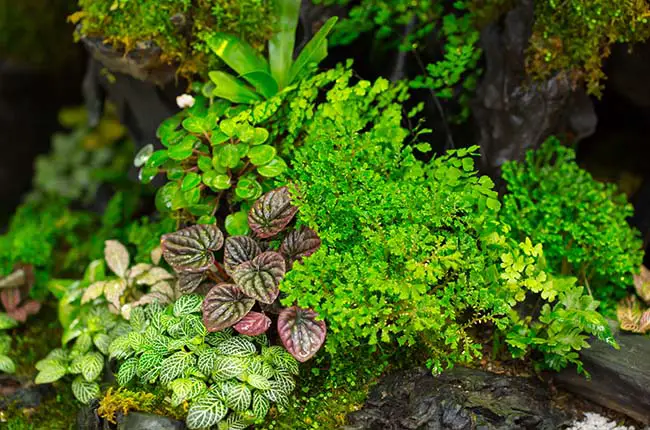Imagine your flower pots and houseplants looking like they’re straight out of a magical fairy tale, complete with lush, velvety green moss.
Moss can be the perfect companion to your houseplants, but not all plant partners are a match made in heaven for moss.
For the moss and the houseplant to thrive together, they should both love moisture, have similar light and temperature needs, and boast complementary growth habits.
In this article, we’ve curated a list of perfect companion plants that can grow hand-in-hand with moss, creating your very own indoor wonderland.
What makes a good companion plant for moss?
When selecting companion plants for moss, it’s important that they can coexist harmoniously and complement each other both visually and functionally. For that, the following factors should be considered:
Shade tolerance
Many moss species (e.g. Pincushion moss, Broom fork moss, feather moss, sheet moss) grow well in low to medium light conditions. Companion plants should have similar light requirements to ensure they can thrive alongside the moss.
Preference for moisture
Moisture is crucial for any species of moss to survive, so plants that grow well with moss should be able to tolerate or thrive in consistently moist soil.
For plants that prefer well-draining soil or are susceptible to root rot (e.g. succulents), using moss to topdress would not be suitable as excessive moisture could lead to root rot and fungal infection.
Complementary growth habits
The ideal plants to grow together with moss should have a trailing, upright, or low-growing habit in order to create a visually appealing contrast with moss, while also promoting a healthy growing environment.
- Trailing plants: These plants grow downward, cascading over the edges of containers or hanging baskets. They add a sense of movement and depth to the arrangement, contrasting with the flat, carpet-like appearance of moss. Since trailing plants don’t directly compete with moss for space, both can coexist without overcrowding.
- Upright plants: As the name suggests, these plants grow vertically, reaching upward toward the light. The height and structure they provide create a striking contrast with the low-lying, cushion-like moss. The vertical growth ensures they don’t smother the moss or compete for the same space, allowing both plants to flourish.
- Low-growing plants: While these plants share a similar growth habit with moss, their distinct foliage texture and form can still create an appealing contrast. Low-growing plants with varied leaf shapes, colors, or patterns can enhance the visual interest of the arrangement without overshadowing the moss.
Growth habits that may not be ideal for moss are those that are highly invasive and grow rapidly with the tendency to spread uncontrollably as that could outcompete the moss for space, nutrients, and light.
List of plants that grow well with moss
Using the criteria mentioned, many plants actually grow very well with moss. Epiphytic plants such as epiphytic orchids and epiphytic cacti in particular are ideal because the water-retentive moss can help keep their aerial roots moist while allowing them ventilated. Ferns are also a great match because they can tolerate shaded and moist environments more than other types of plants.
Here are some examples of companion plants that are ideal for growing with moss:
1. Ripple peperomia (Peperomia caperata)
Peperomia caperata and moss make visually appealing companions because of their contrasting yet complementary textures, shapes, and growth habits.
Peperomia caperata is a compact, bushy plant that can grow to around 8-12 inches (20-30 cm) tall and wide. Its leaves are heart-shaped, deeply ridged and are often dark green with red, silver, or purple hues.
Moss, on the other hand, forms a dense, low-growing carpet with a soft, velvety texture. It has a more uniform and flattened appearance compared to the more three-dimensional structure of Peperomia caperata.
Both of them prefer a growing environment with high humidity and partial light.

(Lazaregagnidze, via Wikimedia Commons)
2. Epiphytic orchids
All types of epiphytic orchids, especially those that prefer or can tolerate low to medium light intensity, are suitable to be grown with moss because they have adapted to be grown on trees to absorb water in the air. Examples of such orchids include Phalaenopsis orchids, Oncidium orchids, Brassia orchids, and Cattleya orchids.
Moss helps to lock in the moisture yet allows their epiphytic roots to breathe. Many of them can grow up to a mature size of 12-24 inches (30-61 cm) tall or up to 10 inches (25cm) tall for miniature orchids.
They have stunning, long-lasting flowers that come in various colors, including white, pink, and purple, making them a beautiful and visually appealing addition to any moss display.

3. Epiphytic cacti
Epiphytic cacti make great companions with moss because they have adapted to grow under bright, indirect light or even partial shade. They also prefer or can tolerate more humidity than desert cacti.
They generally have trailing stems, some with flowers in vibrant colors of pink, red, and white during winter months, creating a beautiful contrast with moss.
Examples of epiphytic cacti include Rhipsalis (Rhipsalis spp.), Cryptocereus (Cryptocereus anthonyanus), Christmas Cactus (Schlumbergera bridgesii), Easter Cactus (Hatiora gaertneri), Orchid Cactus (Epiphyllum spp.).
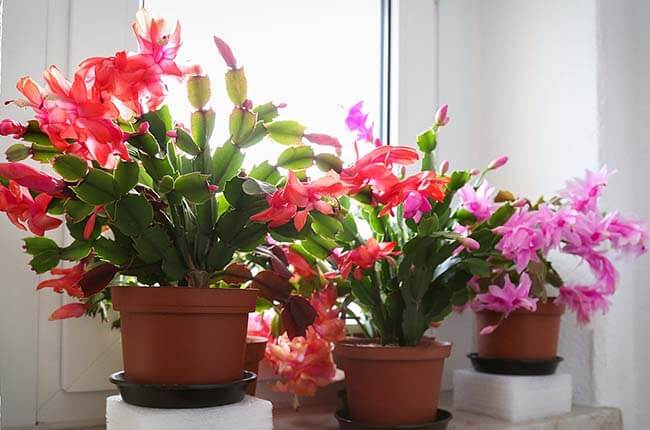
(Maja Dumat from Deutschland (Germany), via Wikimedia Commons)
4. Maidenhair Fern (Adiantum spp.)
Maidenhair Ferns are shade-tolerant and moisture-loving plants, making them ideal companions for moss.
They have delicate, fan-shaped fronds with small, rounded leaflets, creating an elegant and graceful appearance.
Maidenhair Ferns can grow up to 17-19 inches (43-48 cm) tall, making them a beautiful and elegant houseplant option alongside moss.

(Vengolis, CC BY-SA 4.0, via Wikimedia Commons)
5. Boston Fern (Nephrolepis exaltata)
Boston Ferns are shade-tolerant and enjoy moist soil. They have an upright, arching growth habit and can grow up to 24-36 inches (61-91 cm) tall and wide.
Their lush, feathery fronds create a visually appealing contrast with moss and add an elegant touch to any space.

(Jerzy Opioła, CC BY-SA 4.0, via Wikimedia Commons)
6. Japanese Painted Fern (Athyrium niponicum var. pictum)
This shade-tolerant fern thrives in moist soil, making it an excellent companion for moss.
It can reach up to 18 inches (46 cm) tall. The fronds have a unique, silvery-gray color with hints of burgundy, creating a delightful visual distinction when paired with the low-set moss.

(Photo (c)2006 Derek Ramsey (Ram-Man), CC BY-SA 2.5, via Wikimedia Commons)
7. Hosta
Also known as “Plantain Lily”, Hostas are shade-tolerant perennials that enjoy high levels of humidity.
Depending on the variety, they have large, attractive leaves, reaching heights of between 0.5 – 3 feet 18-24 inches (46-61 cm).
Hosta leaves come in various shades of green, often with variegated patterns, and they produce tall, slender flower stalks with small, trumpet-shaped flowers.
With their appealing leaves and fragile blooms, these plants create an engaging visual counterpoint to the unassuming, ground-hugging moss.

(Agnieszka Kwiecień, Nova, CC BY-SA 4.0, via Wikimedia Commons)
8. Nerve Plant (Fittonia albivenis)
Nerve Plants are shade-tolerant and moisture-loving, just like many moss species.
They have small, oval-shaped leaves with intricate, contrasting veins in colors like red, pink, or white. The unique vein patterns make them attractive and interesting additions to a moss display.
Nerve Plants can grow up to 6 inches (15 cm) tall, with leaves measuring around 2 inches (5 cm) long.
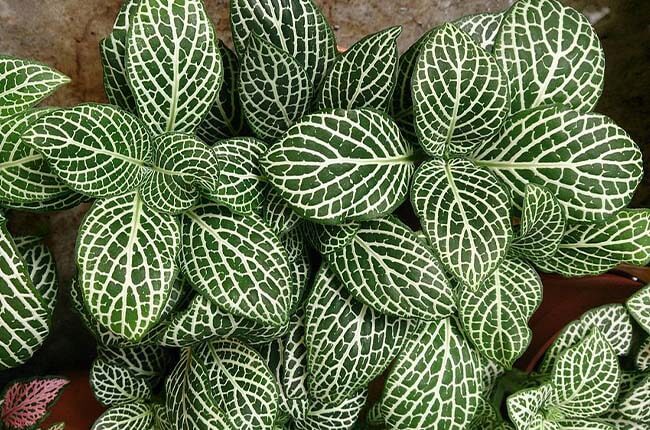
(Mokkie, CC BY-SA 3.0, via Wikimedia Commons)
9. Peace Lily (Spathiphyllum spp.)
Peace Lilies thrive in partial shade and high-humidity environments.
They have large, glossy green leaves and produce elegant white flowers that contrast with the dark green leaves.
Peace Lilies can grow up to 24 inches (61 cm) tall, depending on the variety.

(Forest & Kim Starr, CC BY 3.0, via Wikimedia Commons)
10. Pothos (Epipremnum aureum)
Pothos plants are shade-tolerant and can handle varying moisture levels, making them good companions for moss.
They have long trailing vines with heart-shaped leaves that come in various shades of green. Some varieties have unique variegated patterns.

(Spnq, CC BY-SA 4.0, via Wikimedia Commons)
11. Spider Plant (Chlorophytum comosum)
Spider Plants can tolerate low light levels and enjoy moist soil.
They have arching, grass-like leaves with white or yellow stripes and produce tiny white flowers on long, trailing stems.
Spider Plants can grow up to 12 inches (30 cm) tall, with trailing stems reaching lengths of 18 inches (46 cm) or more.

(Photo by David J. Stang, CC BY-SA 4.0, via Wikimedia Commons)
12. Calathea (Calathea spp.)
Given their preference for low light and moist environments, Calatheas are well-adapted to flourish alongside moss.
They can grow up to 24 inches (61 cm) tall, depending on the variety.
They have large, striking leaves with intricate patterns and colors, including shades of green, purple, and silver.

(Ping an Chang, CC BY-SA 4.0, via Wikimedia Commons)
13. Prayer Plant (Maranta leuconeura)
Prayer Plants are shade-tolerant and enjoy moist soil.
They have oval-shaped leaves with unique patterns and colors, including green, red, and purple. The leaves fold up at night like praying hands, adding to their charm and beauty.
Prayer Plants can grow up to 12 inches (30 cm) tall, with leaves measuring around 4 inches (10 cm) long.

(Yercaud-elango, CC BY-SA 4.0, via Wikimedia Commons)
14. Chinese Evergreen (Aglaonema spp.)
With their affinity for shade and moisture, Chinese Evergreens make an excellent match for cohabitating with moss.
They can grow up to 24 inches (61 cm) tall, with leaves measuring up to 12 inches (30 cm) long.
They have large, glossy leaves with a variety of patterns and colors, including shades of green, silver, and red. Their unique foliage patterns and colors make them stand out among other houseplants.
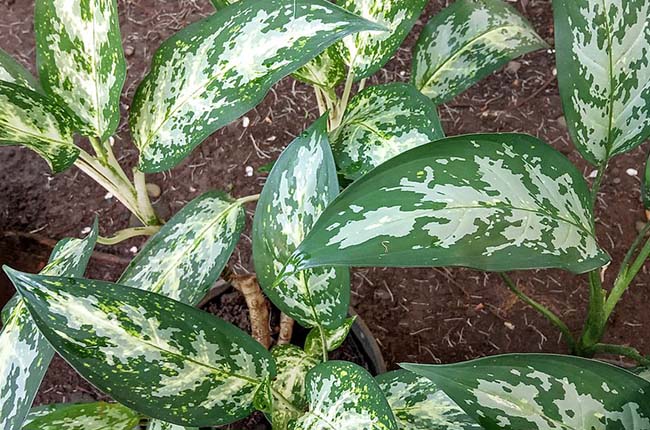
(Setiawanap, CC BY-SA 4.0, via Wikimedia Commons)
15. Flamingo Lily (Anthurium andraeanum)
Anthuriums have large, glossy, heart-shaped leaves and produce striking, long-lasting flowers that come in various colors, such as red, pink, and white.
The combination of their unique flowers and glossy foliage make them beautiful and unique houseplants.
Anthuriums can grow up to 12-18 inches (30-45 cm) tall, depending on the variety.

(Alejandro Bayer Tamayo from Armenia, Colombia, CC BY-SA 2.0, via Wikimedia Commons)
16. English Ivy (Hedera helix)
English Ivy can tolerate low light levels and prefers well-drained but consistently moist soil, making it compatible with moss.
Its long trailing stems can create an interesting visual contrast with low-growing moss. Its attractive, lobed leaves come in various shades of green, sometimes with variegated patterns, making it a beautiful houseplant.
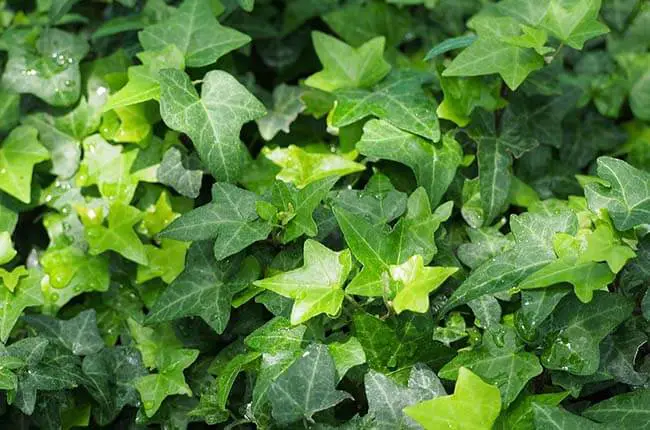
(Agnieszka Kwiecień, Nova, CC BY-SA 4.0, via Wikimedia Commons)
17. Parlor Palm (Chamaedorea elegans)
Parlor Palms can tolerate low light levels and prefer consistently moist soil.
Their upright stems can grow up to 48 inches (122 cm) tall.
The graceful, feathery fronds and compact size make them a beautiful and unique houseplant that adds a tropical feel to any space.

(Tangopaso, Public domain, via Wikimedia Commons)
18. Coral Bells (Heuchera spp.)
Coral Bells are shade-tolerant and prefer an even supply of moisture which is perfect with water-retentive moss.
They grow vertically and can reach 8 to 18 inches (20 – 46 cm) tall.
The striking foliage comes in various colors, including shades of green, purple, and silver, and they produce tall, slender flower stalks. The combination of colorful foliage and delicate flowers makes them a beautiful and unique houseplant.

(Tahota at English Wikipedia, Public domain, via Wikimedia Commons)
19. Bleeding Heart (Dicentra spectabilis)
Bleeding Heart plants thrive in shade and moist soil, making them ideal for growing alongside moss.
Their unique, heart-shaped flowers hang from arching flower stems and come in shades of pink and white, adding a touch of romance to any display.

(Glysiak, CC BY-SA 4.0, via Wikimedia Commons)
Happy gardening!
Related
Growing Orchids with Live Moss? (Pros & Cons Examined)
Top 16 Mosses for Indoor Plants & Living Wall
How Much Light Does Moss Need? (List Included)
- Top 6 Drip Irrigation Systems for Raised Beds (2025) - January 31, 2025
- Top 10 Orchid Fertilizers: A Comprehensive Review (2025) - January 16, 2025
- Top 6 Slow-Release Fertilizers for Houseplants & Veggies (2025) - January 15, 2025

